Florida’s wild side is under siege, from the Everglades to the Atlantic coast.
Invasive species are crowding out natives, overrunning neighborhoods, and threatening crops, wildlife, and even our backyards.
Some were stowaways, while others were intentionally released. Now they’re EVERYWHERE, birds, bugs, beasts, and plants.
⬇️ Here are the top 25 worst offenders ⬇️
Invasive Birds (Terrestrial)
European Starling (Sturnus vulgaris)
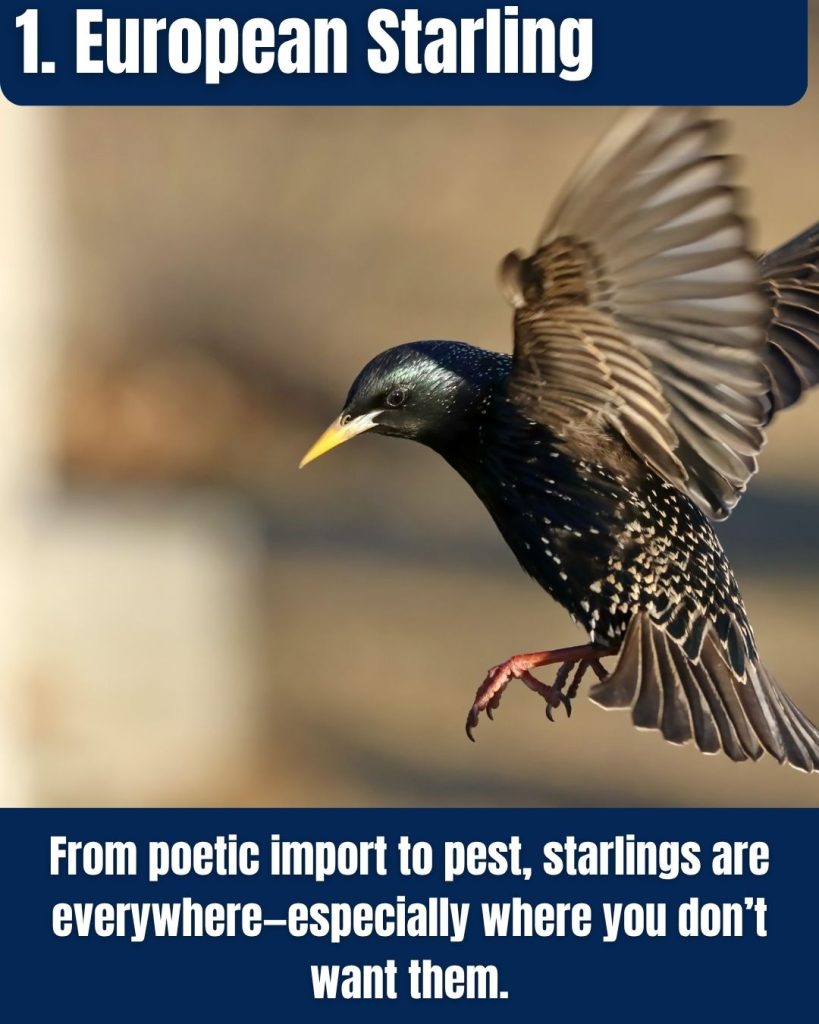
- Sky squatter: Competes fiercely for nesting holes, evicting bluebirds and woodpeckers.
- Crop destroyer: Raids fruit and grain fields, causing massive agricultural losses.
- Dirty dozens: Large flocks leave behind slippery, bacteria-filled droppings on sidewalks and cars.
From poetic beginnings to public enemy number one, European starlings now dominate Florida’s urban and rural spaces.
They show up in massive flocks, outmuscle native birds, and leave a mess wherever they go. Their population boom means big headaches for both farmers and city dwellers alike.
House Sparrow (Passer domesticus)
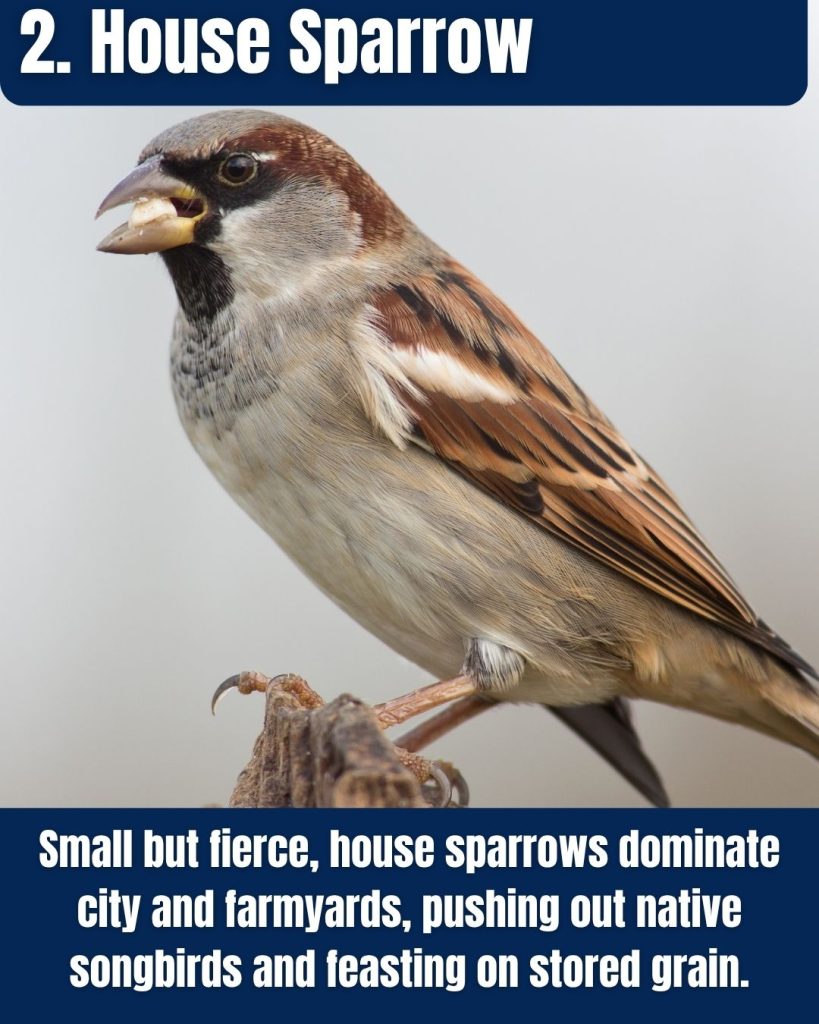
- Ruthless nest raider: Evicts native birds from nesting boxes, often killing their young.
- Human hanger-on: Thrives near homes, barns, and restaurants across Florida.
- Reproduction machine: Multiple broods each year overwhelm native bird populations.
Brought over for “insect control,” house sparrows became one of Florida’s most common backyard invaders.
Aggressive and adaptable, they chase out native songbirds and help themselves to food meant for pets, livestock, or people.
Monk Parakeet (Myiopsitta monachus)
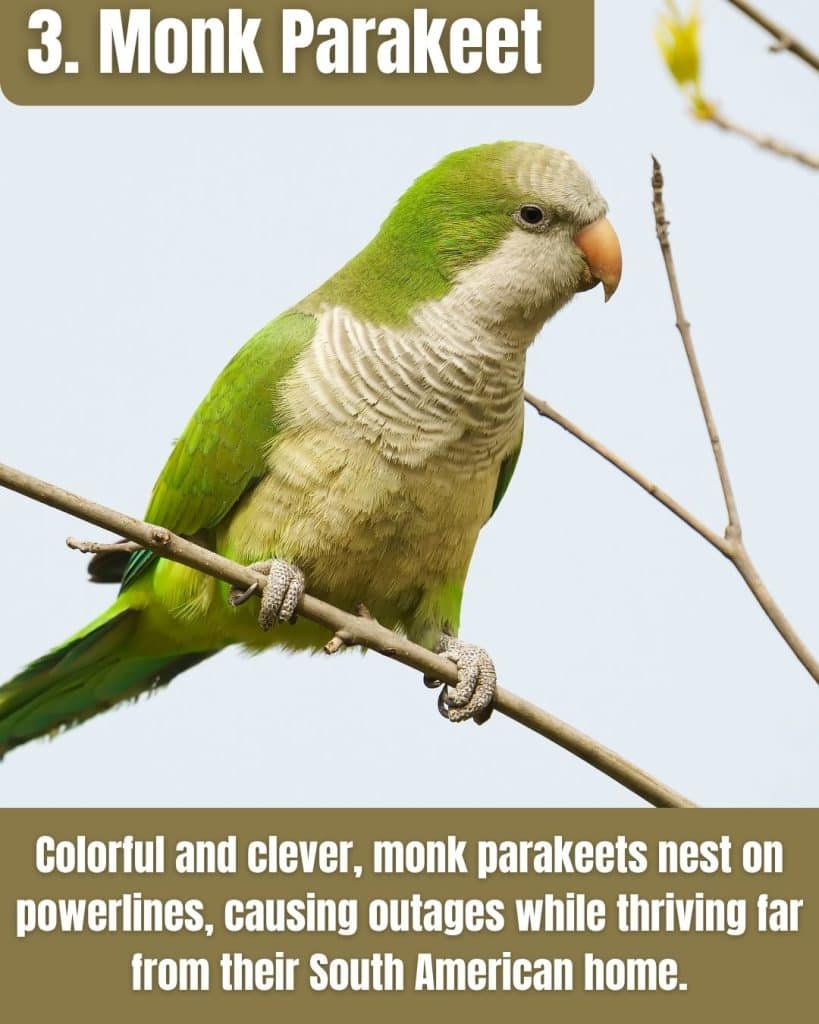
- Green invader: Builds giant stick nests on power poles and stadium lights.
- Expensive outages: Nests can cause power failures and even fires.
- Feral flocks: Now established from Miami to Tampa, competing with local birds.
Bright, noisy, and highly social, monk parakeets escaped the pet trade and now thrive in Florida’s cities.
Their giant communal nests clog electrical infrastructure, sometimes causing costly blackouts, and their presence crowds out native birds.
Eurasian Collared-Dove (Streptopelia decaocto)
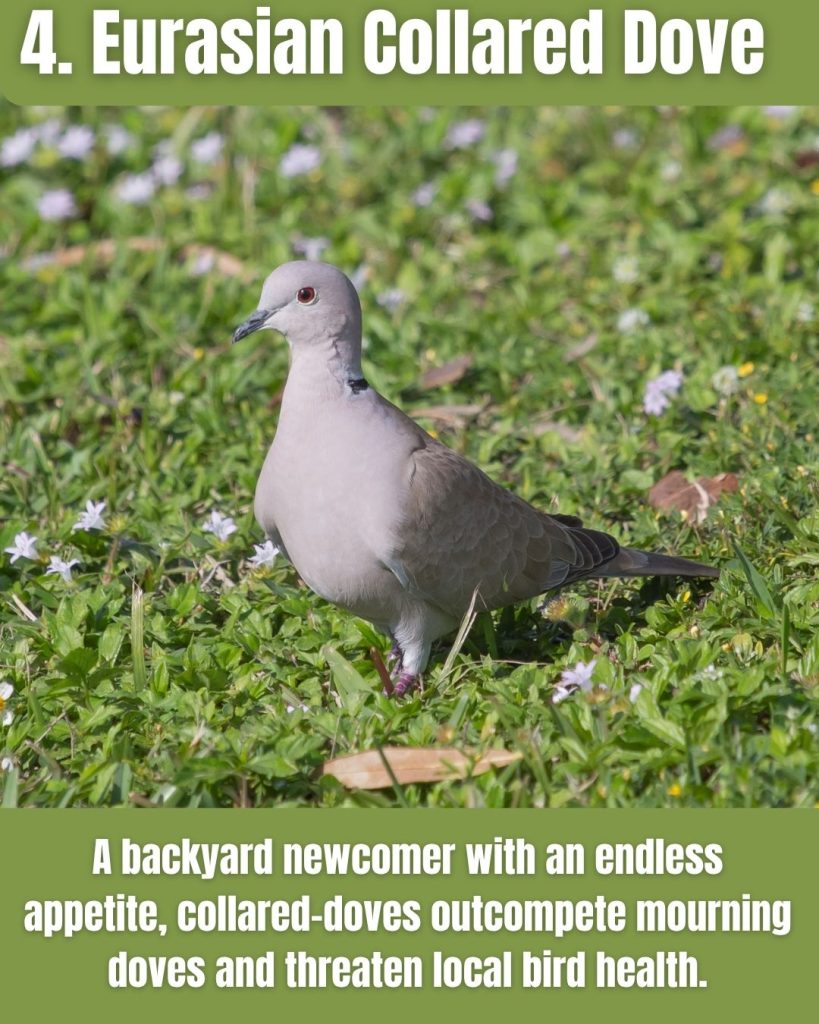
- Rapid spreader: From a handful in the 1980s to statewide domination.
- Big, bold, and noisy: Pushes out native mourning doves and songbirds.
- Messy flocking: Roosts by the hundreds in palm trees and shopping centers.
First reported in Florida only a few decades ago, Eurasian collared-doves now thrive from the Panhandle to the Keys.
They bully native doves, crowd bird feeders, and blanket trees in noisy flocks.
Mute Swan (Cygnus olor)
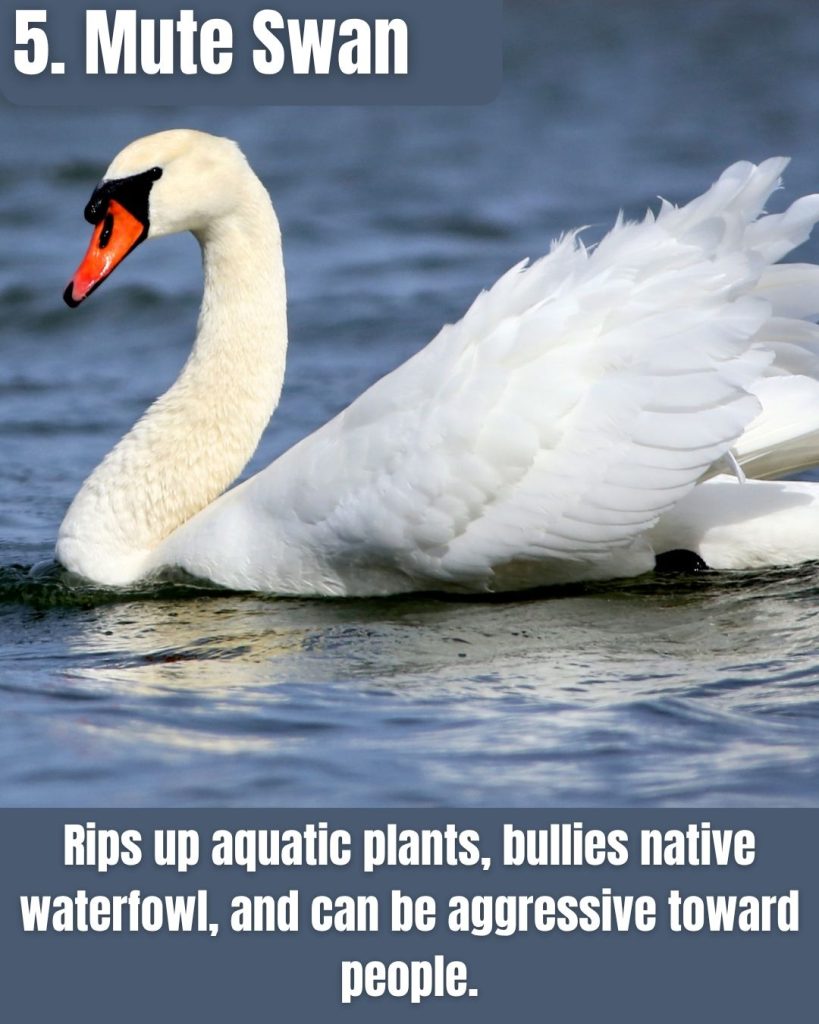
- Aggressive beauty: Drives out native waterfowl and even attacks people.
- Hunger machines: Strip lakes of aquatic plants and muddy the water.
- Nonstop breeders: Large, territorial flocks on Florida lakes and ponds.
They look graceful, but mute swans are bullies on the water.
They rip up plants, chase off ducks, and will even charge at kayakers and pets.
Florida’s lakes are less peaceful when these white giants take over.
Invasive Insects
Red Imported Fire Ant (Solenopsis invicta)
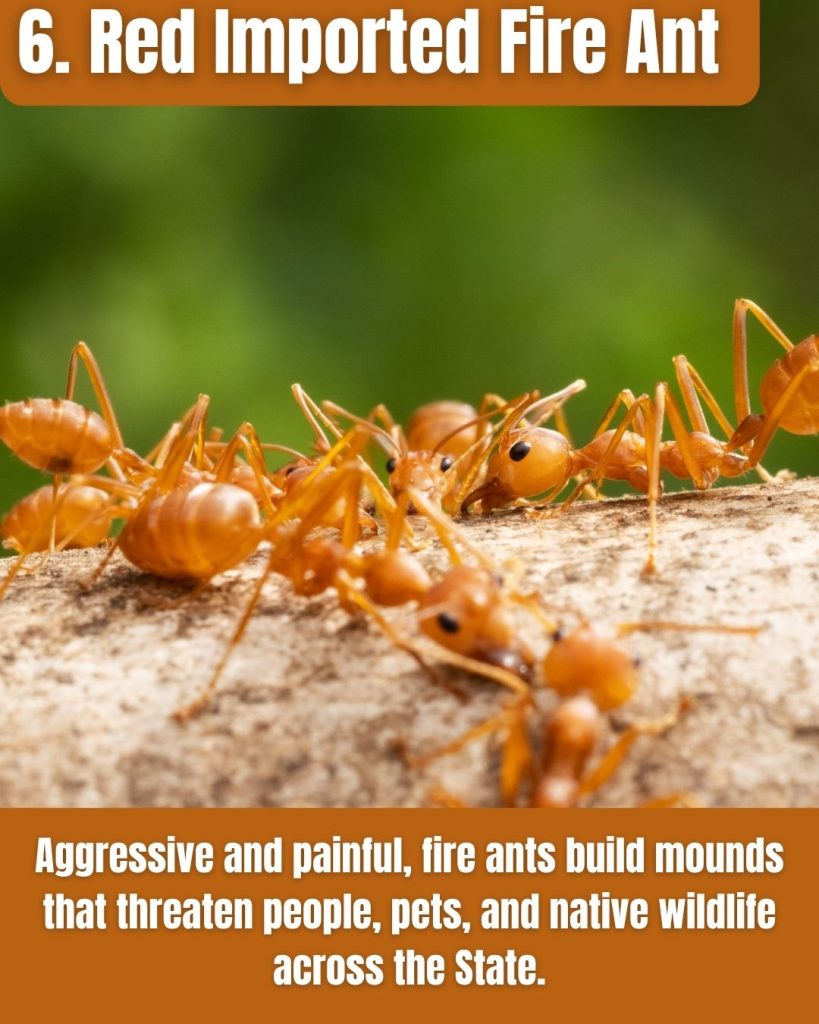
- Painful stings: Cause allergic reactions, injuries, and sometimes death.
- Aggressive mounds: Pop up overnight, invading lawns and playgrounds.
- Livestock threat: Kill newborn wildlife and damage farm equipment.
Step on a mound and you’ll never forget it.
Imported fire ants swarm and sting with burning venom, forcing people and pets indoors.
They even damage electrical boxes, creating fire risks and expensive repairs.
Asian Tiger Mosquito (Aedes albopictus)
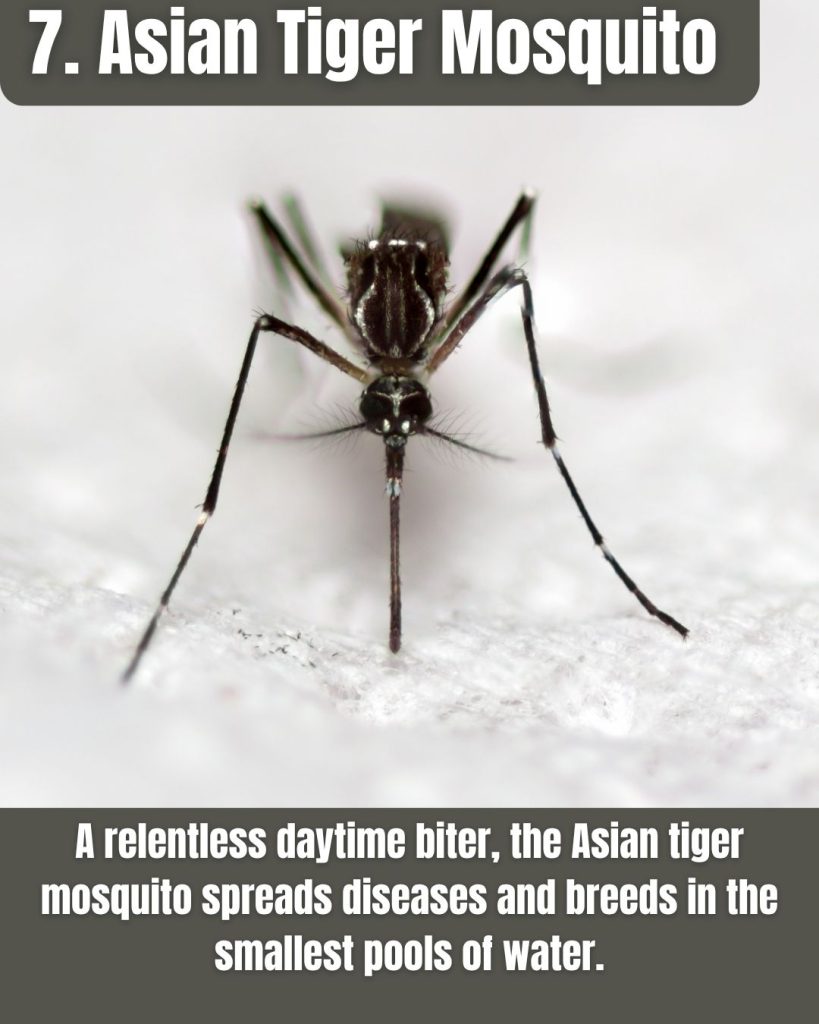
- Daytime biters: Active all day, not just at dusk.
- Disease vectors: Spread Zika, dengue, and other viruses.
- Container breeders: Lay eggs in anything holding water… gutters, pots, even bottle caps.
These small black-and-white mosquitoes are relentless, biting people from sunrise to sunset.
Their rapid spread across Florida puts everyone at risk of mosquito-borne illness, and they thrive anywhere there’s a bit of standing water.
Giant African Land Snail (Lissachatina fulica)
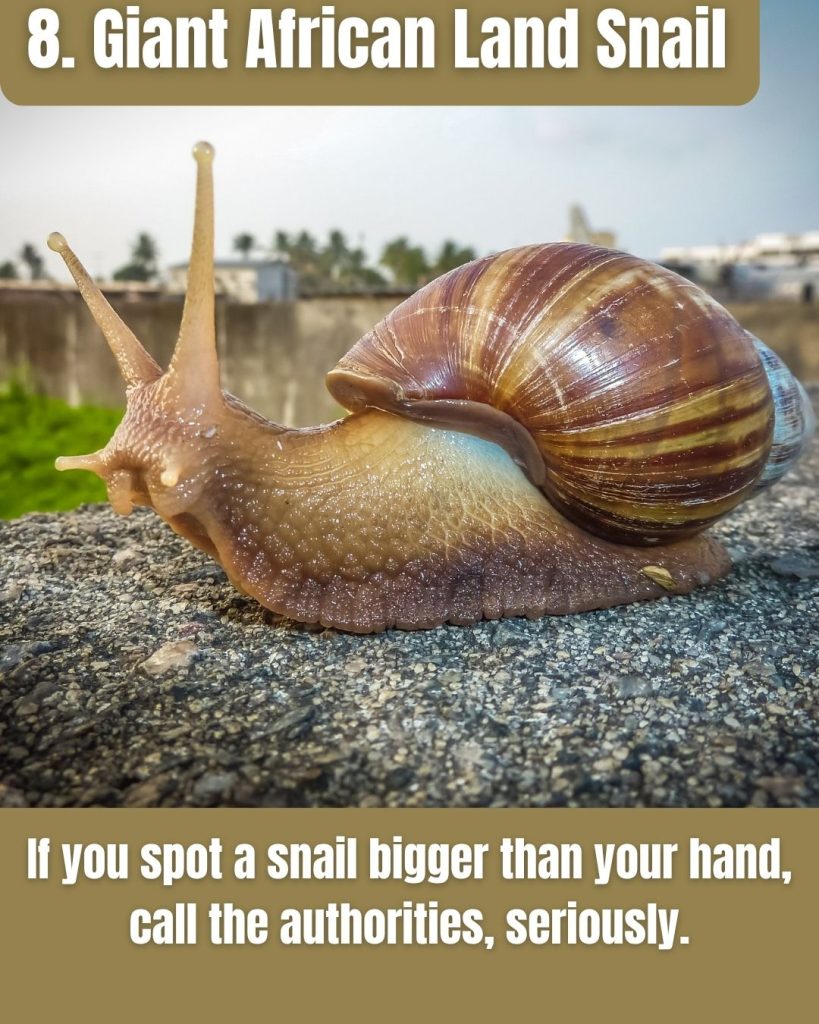
- Super-sized pest: Grows up to 8 inches long and devours 500+ plant species.
- Property damage: Eats stucco and concrete to get calcium for its shell.
- Disease risk: Spreads rat lungworm, dangerous to humans and pets.
So big they’re almost comical, these snails eat everything from gardenias to house siding.
Florida has spent millions trying to eradicate them, but they keep coming back, posing a health threat and devouring landscapes.
Citrus Greening Psyllid (Diaphorina citri)
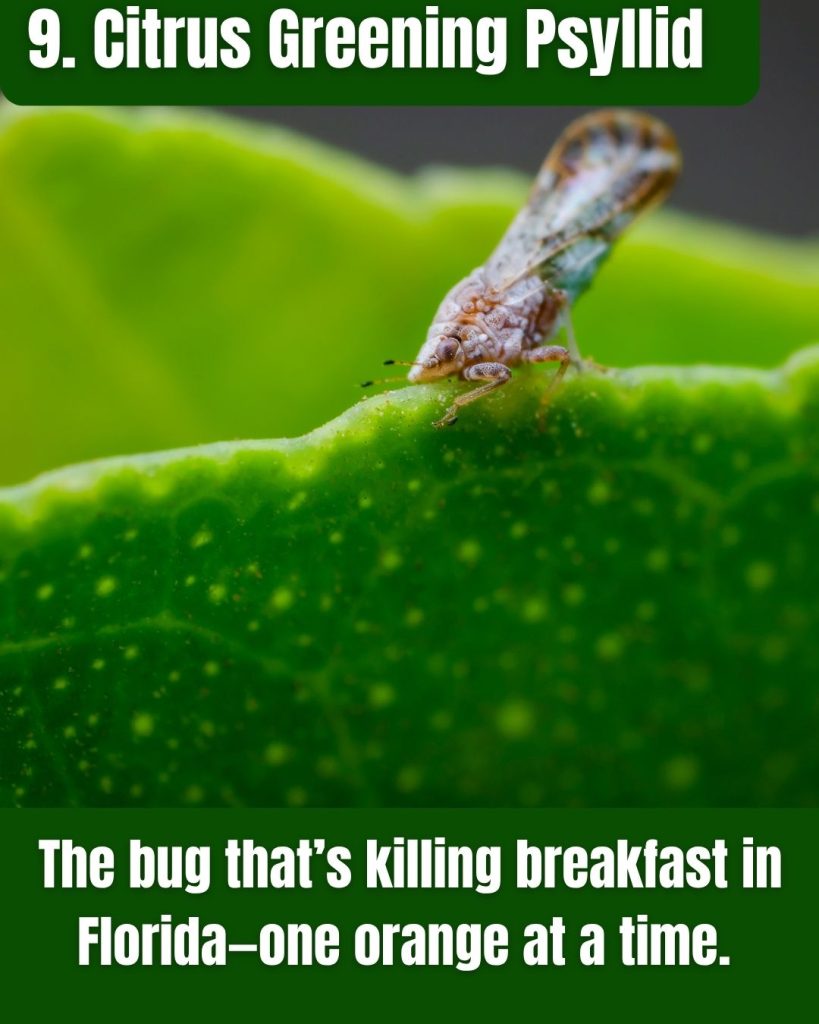
- Silent killer: Spreads the bacteria that causes citrus greening disease.
- Fruit destroyer: Kills orange, grapefruit, and lemon trees, devastating Florida’s iconic groves.
- No cure: Once infected, trees slowly die; there’s no fix.
Tiny but deadly, this bug carries citrus greening, a disease that has cost Florida’s citrus industry billions.
Sick trees stop producing fruit and eventually die, changing the landscape (and breakfast tables) of Florida forever.
Formosan Subterranean Termite (Coptotermes formosanus)
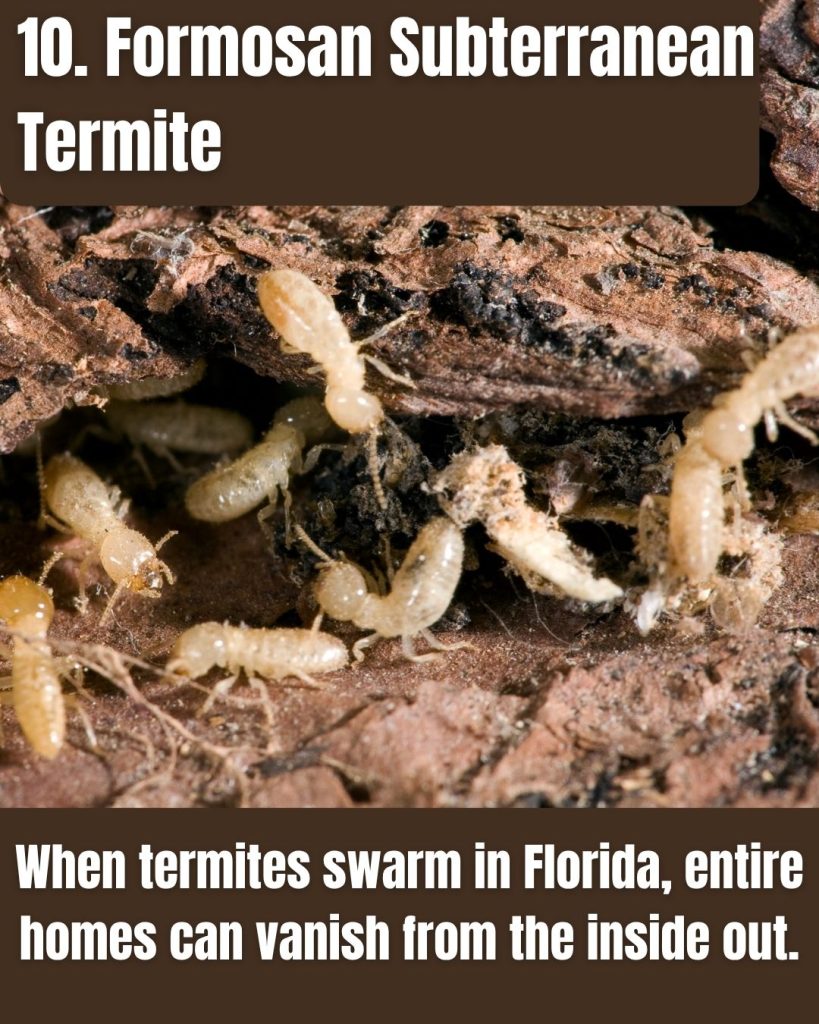
- Super termite: Forms colonies with millions of hungry workers.
- Rapid destruction: Eats through wood, floors, and even foam insulation.
- Costly invader: Billions in property damage across Florida.
They hide underground and inside walls, multiplying by the millions.
Formosan termites are responsible for some of Florida’s most shocking home repair bills, chewing through neighborhoods and leaving little but sawdust behind.
Invasive Animals (Mammals, Reptiles, Amphibians)
Burmese Python (Python bivittatus)
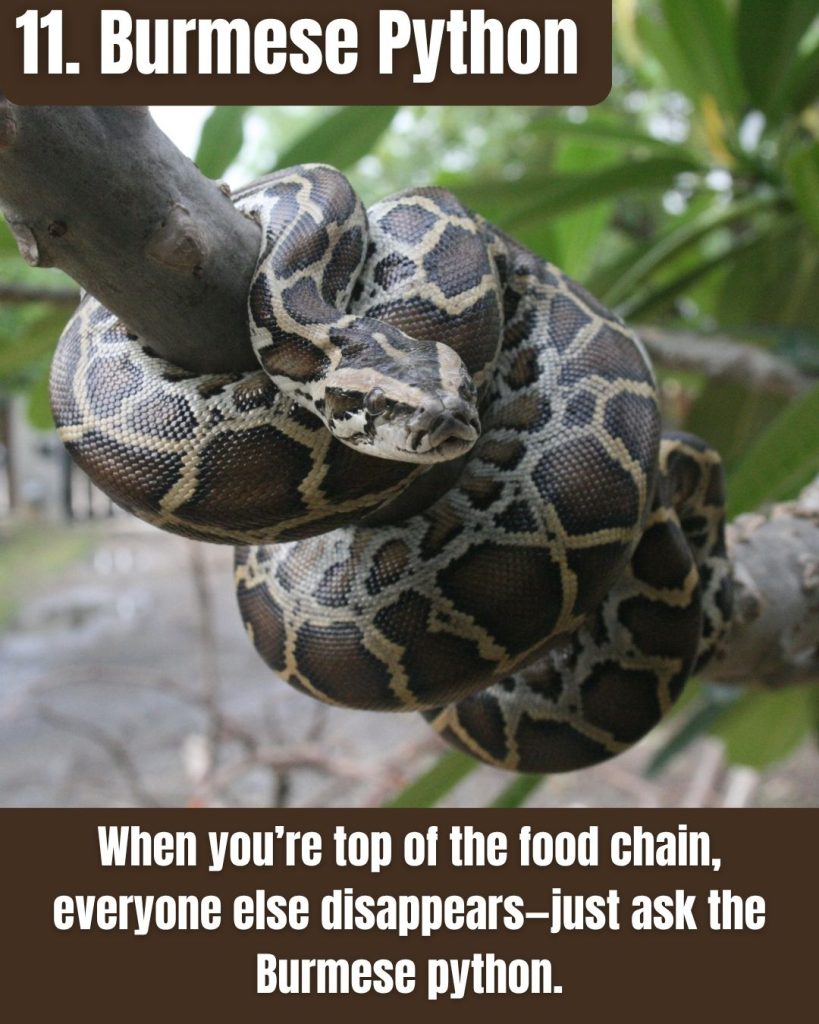
- Giant constrictor: Can grow over 18 feet long and swallow deer, raccoons, even alligators.
- Silent killer: Decimated mammal and bird populations in the Everglades.
- Hard to control: Females lay dozens of eggs; snakes are masters at hiding.
Released pets became an ecological disaster.
Burmese pythons now dominate south Florida’s wetlands, wiping out rabbits, opossums, even bobcats.
Hunters can barely keep up with their spread, and native wildlife pays the price.
Green Iguana (Iguana iguana)

- Yard wreckers: Dig up sidewalks, pool decks, and seawalls with burrows.
- Garden destroyers: Devour fruit, flowers, and vegetable gardens.
- Cold-blooded crashers: In winter, stunned iguanas fall out of trees onto cars and patios.
These giant lizards bask on rooftops, dig tunnels under seawalls, and eat every hibiscus in sight.
When cold weather hits, they fall out of trees, sometimes right onto your lawnmower or barbecue grill.
Feral Hog (Sus scrofa)
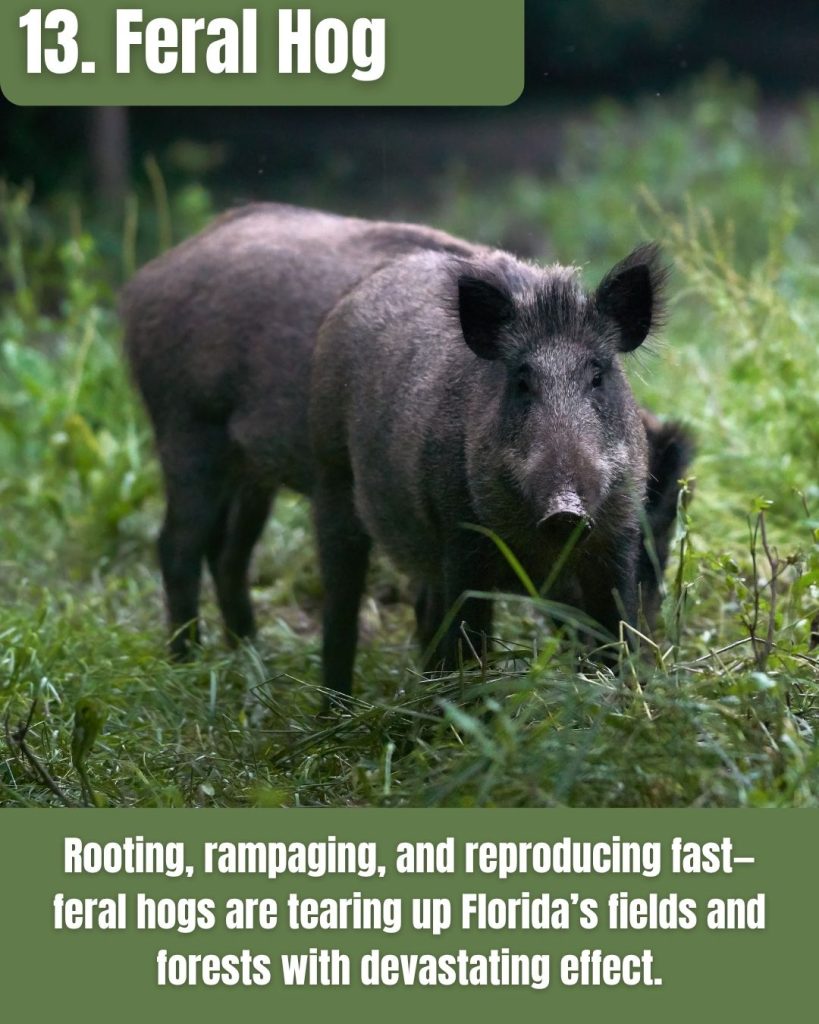
- Rooting vandals: Destroy crops, lawns, and natural areas in search of food.
- Disease spreaders: Carry swine brucellosis and pseudorabies, which threaten livestock.
- High cost: They cause millions in damage each year to Florida agriculture.
Feral hogs root up fields, forests, and even suburban lawns.
They eat anything, reproduce rapidly, and are nearly impossible to eradicate. The damage to crops, fences, and wild spaces adds up fast.
Cuban Treefrog (Osteopilus septentrionalis)
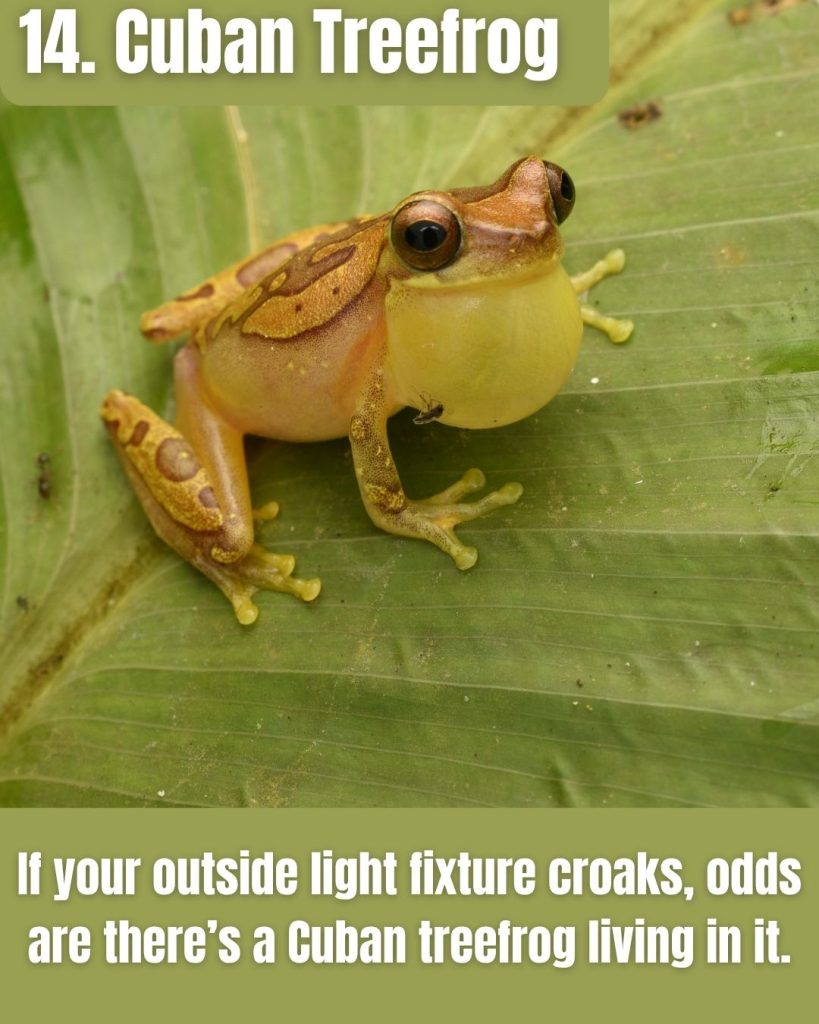
- Giant climber: Grows bigger than any native Florida treefrog.
- Predator of natives: Eats smaller frogs, lizards, and even other treefrogs.
- Home invader: Sneaks into pipes, toilets, and backyard lights.
Florida’s biggest treefrog hides in mailboxes, gutters, and pool skimmers.
They outcompete and eat native frogs, and their sticky skin can even irritate pets and people who handle them.
Black and White Tegu (Salvator merianae)
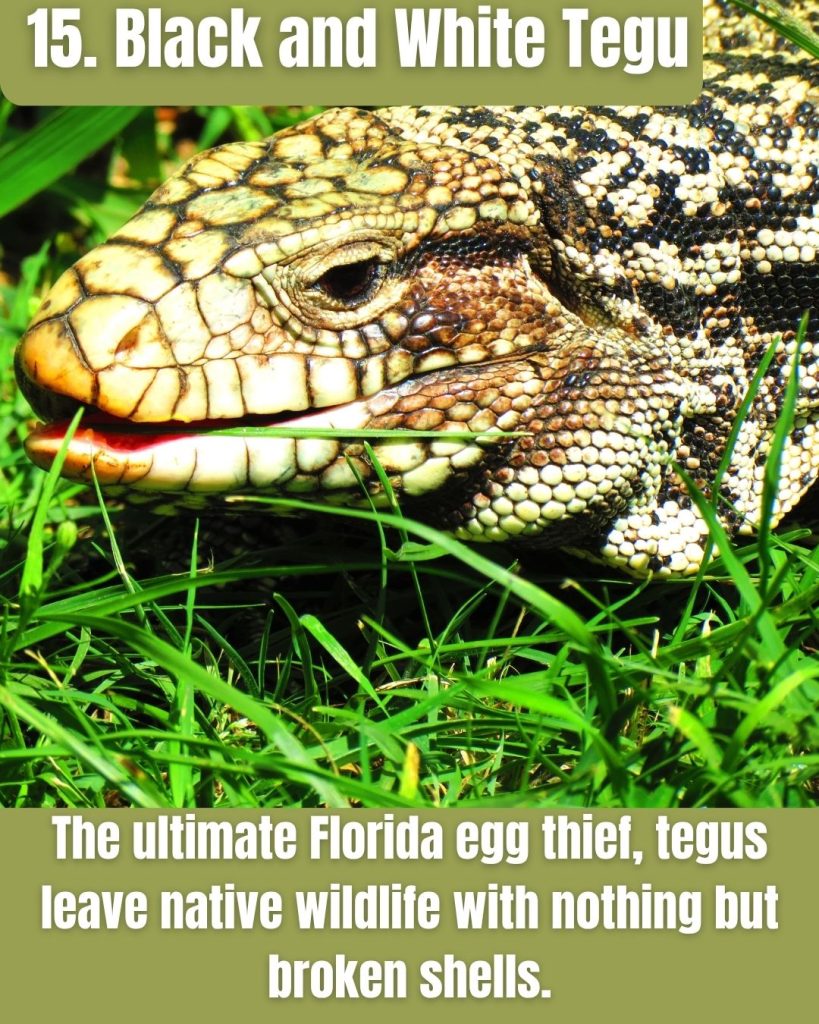
- Egg thief: Raids nests of native turtles, alligators, and birds.
- Cold tolerant: Can survive north Florida winters and spread fast.
- Pet trade escapee: Released pets now threaten native wildlife.
These large, powerful lizards dig up eggs from threatened gopher tortoises, ground-nesting birds, and even alligators.
Adaptable and fast-breeding, tegus are moving north and expanding their territory every year.
Invasive Fish & Aquatic Species
Lionfish (Pterois volitans)
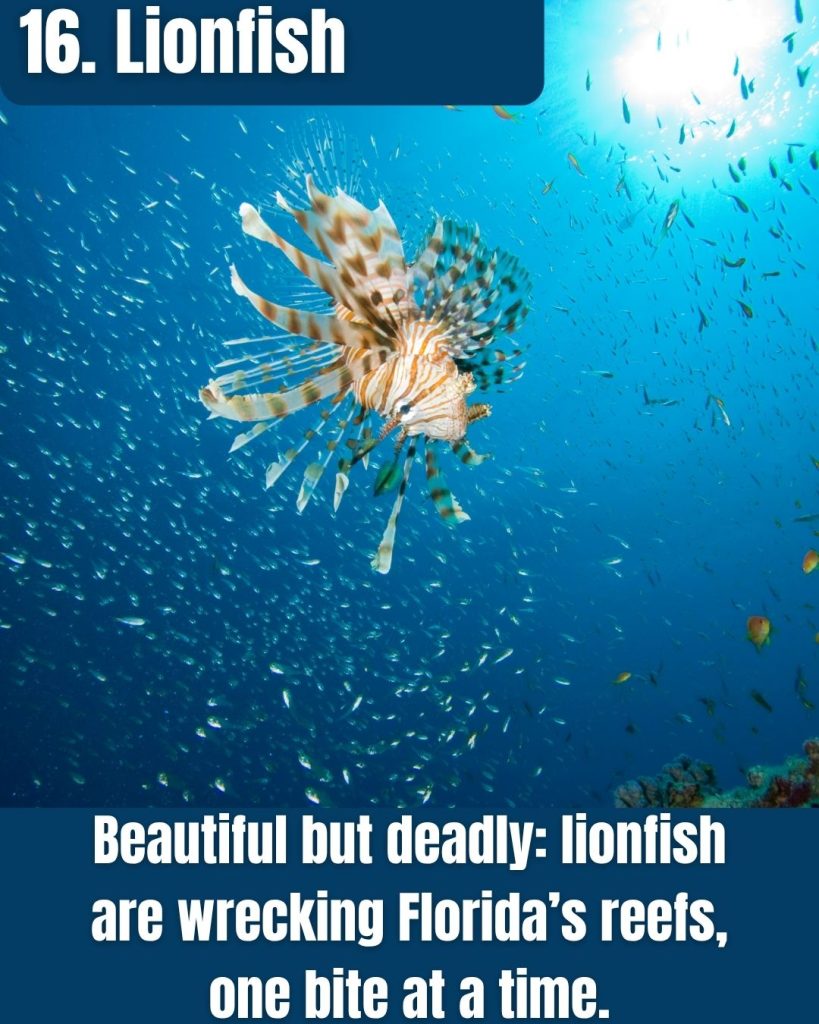
- Venomous spines: Painful sting to swimmers and divers.
- Relentless predator: Eats everything, wiping out native fish on Florida’s reefs.
- Egg factory: Females release up to two million eggs a year.
Lionfish are a stunning sight on the reef—but deadly for native species.
With no natural predators, they devour young snapper, grouper, and shrimp, causing fish populations to crash.
Walking Catfish (Clarias batrachus)
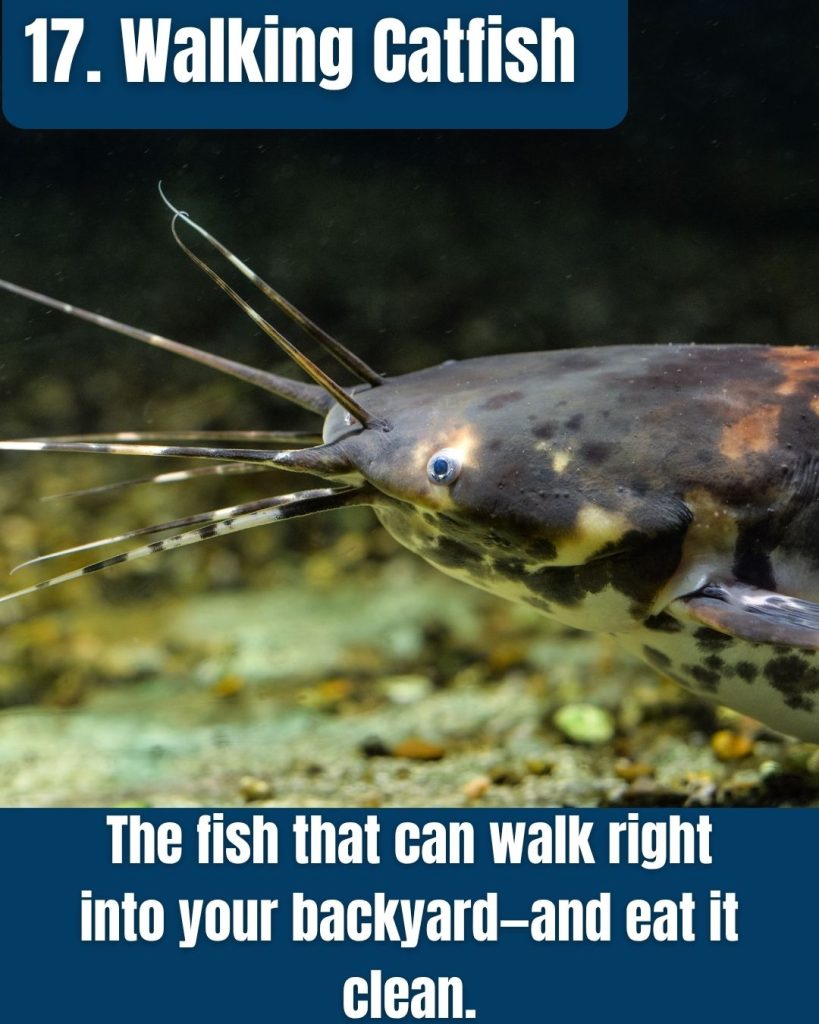
- Land crawler: Moves over lawns and streets after rain, invading new ponds.
- Outcompetes natives: Eats everything in its path, including fish eggs and fry.
- Aquaculture pest: Raids fish farms and backyard ponds across south Florida.
These fish can “walk” on land using their fins, letting them colonize new waters after storms.
They gulp air, eat everything, and devastate aquaculture operations and native fish alike.
Blue Tilapia (Oreochromis aureus)
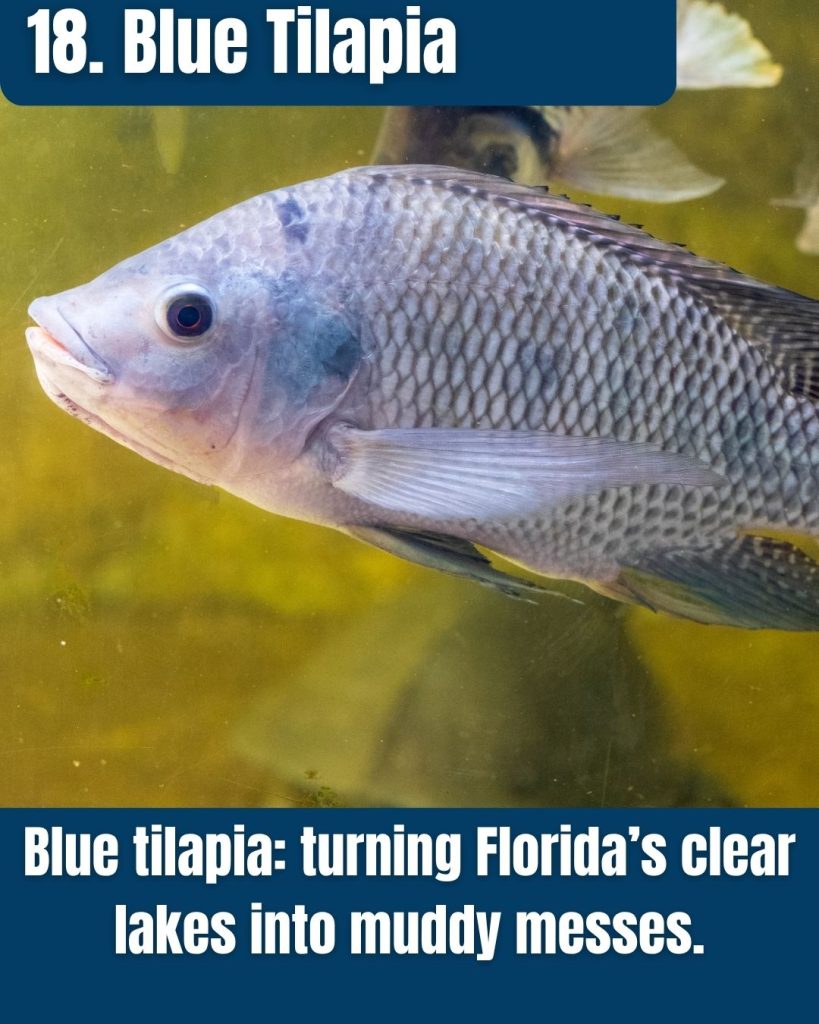
- Population explosions: Outcompetes and displaces native fish in lakes and canals.
- Vegetation eater: Devours aquatic plants, turning clear lakes into mud puddles.
- Farm escapee: Originally introduced for aquaculture; now common in the wild.
Blue tilapia are hardy and breed rapidly, overwhelming native fish and taking over freshwater lakes.
Their appetite for plants makes water quality worse, harming fish and birds that depend on clean habitat.
Suckermouth Catfish (Hypostomus plecostomus)
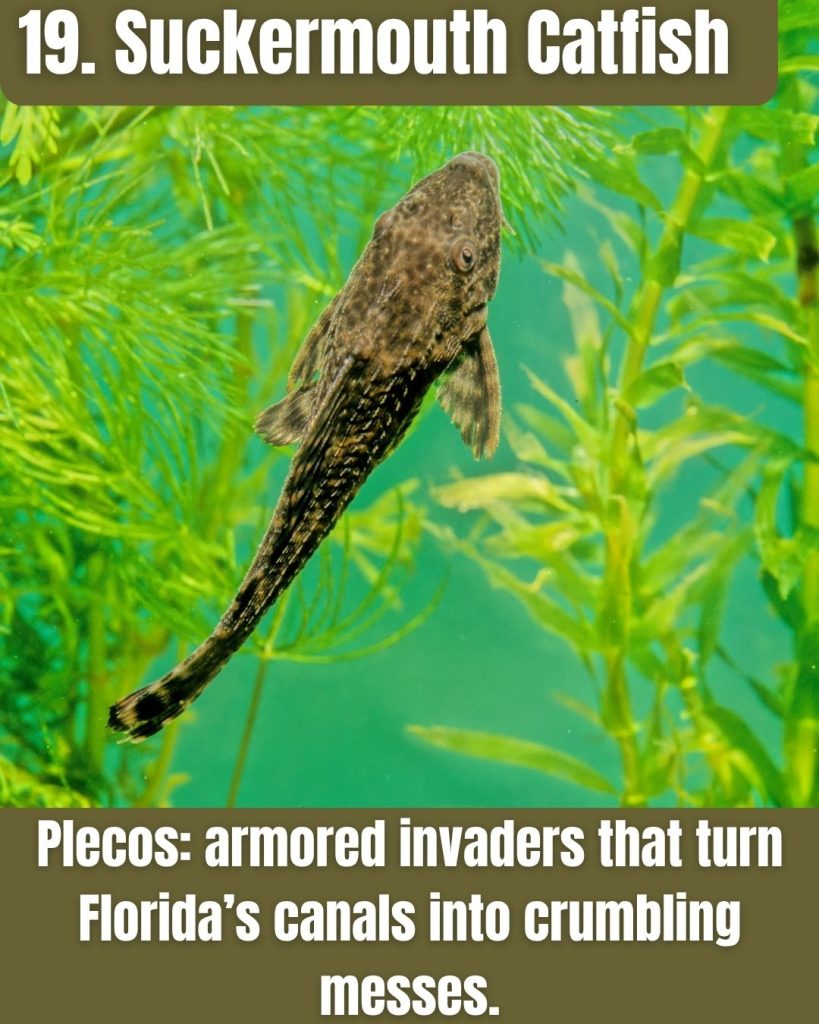
- Algae eater: Cleans tanks, but in the wild, overpopulates rivers and canals.
- Burrower: Digs into banks, causing erosion and collapses.
- Armor-plated pest: Few predators due to bony plates and sharp spines.
Common in aquariums, plecos released into Florida waters breed rapidly.
They burrow into canal banks, causing erosion and threatening flood control systems, while crowding out native species.
Apple Snail (Pomacea canaliculata)
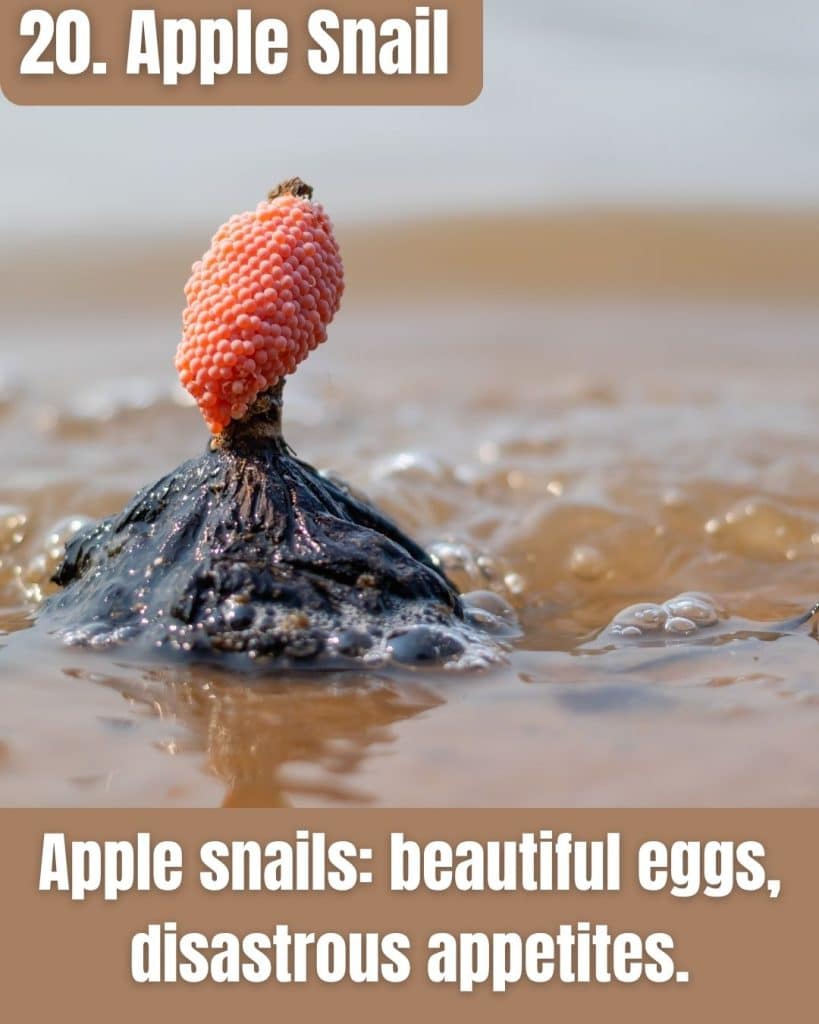
- Egg layer: Bright pink egg masses on cattails and docks.
- Plant destroyer: Eats through wetlands, rice, and aquatic plants.
- Alien appetite: Large snails devour everything—leaving wetlands barren.
These softball-sized snails eat plants at a shocking rate, stripping marshes and ponds bare.
Their bright pink egg clusters are a telltale sign you’re dealing with an infestation.
Invasive Plants
Brazilian Pepper Tree (Schinus terebinthifolius)
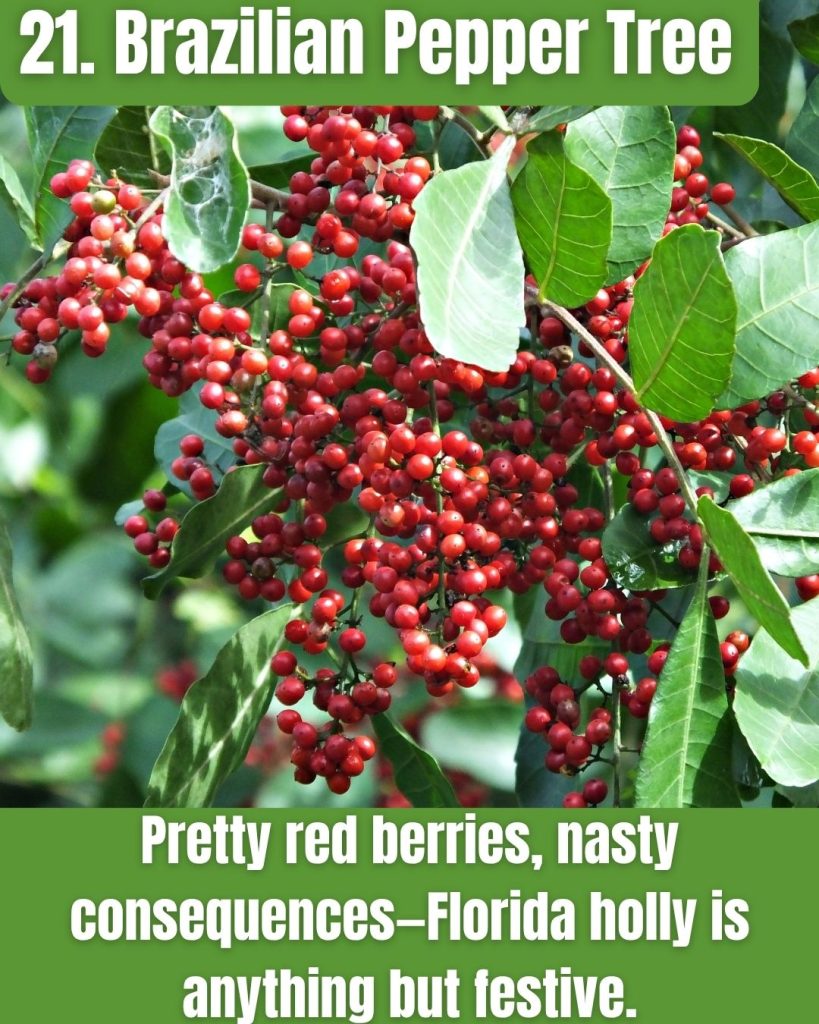
- Thick thickets: Forms dense, impenetrable stands that shade out native plants.
- Allergic reactions: Sap causes skin rashes and respiratory irritation.
- Bird food: Berries attract birds that spread seeds far and wide.
Also known as “Florida holly,” Brazilian pepper takes over pastures, parks, and roadside ditches, forming thickets that block sunlight and crowd out native plants.
Its berries entice birds, which spread this pest far and wide, while its sap can trigger nasty allergic reactions for folks who work nearby.
Australian Pine (Casuarina equisetifolia)
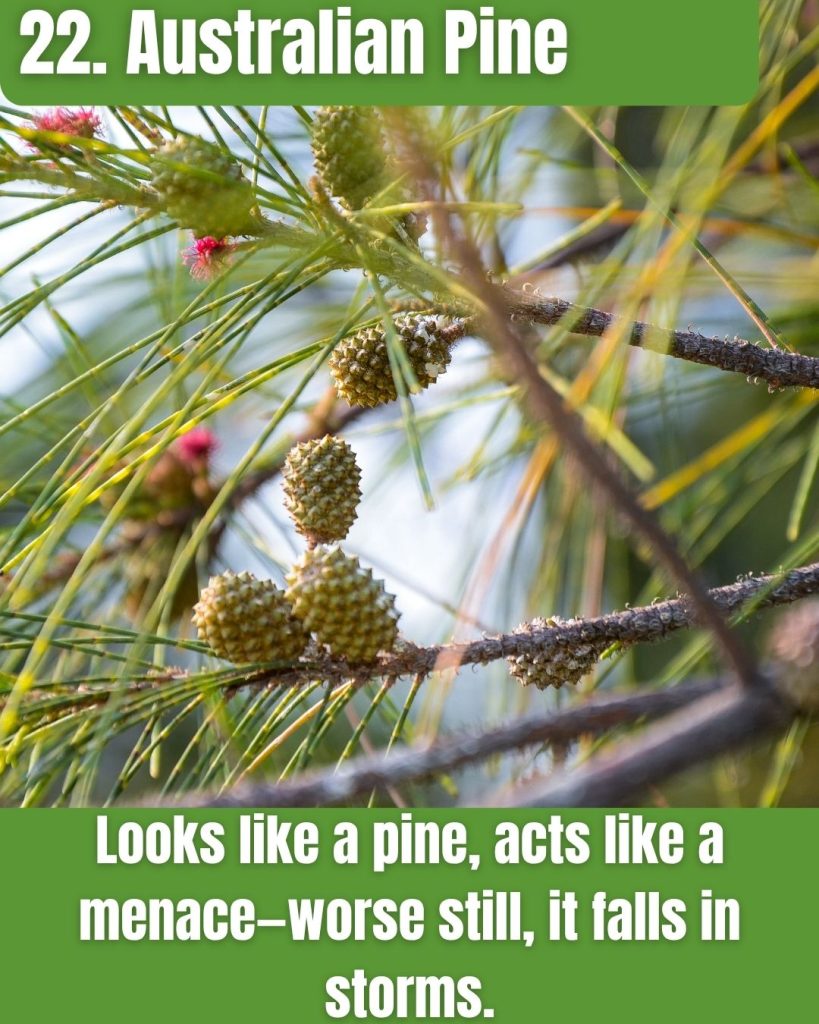
- Beach invader: Crowds out native dune plants along coastlines.
- Hurricane hazard: Shallow roots topple easily in storms.
- Pine imposter: Not a true pine, but just as tough to control.
Australian pines tower along Florida’s beaches, but they’re no friend to the coast.
Their shallow roots make them prone to toppling during hurricanes, and they outcompete native plants that protect our dunes and support sea turtles.
Despite the name, these quick-spreaders aren’t true pines at all.
Old World Climbing Fern (Lygodium microphyllum)
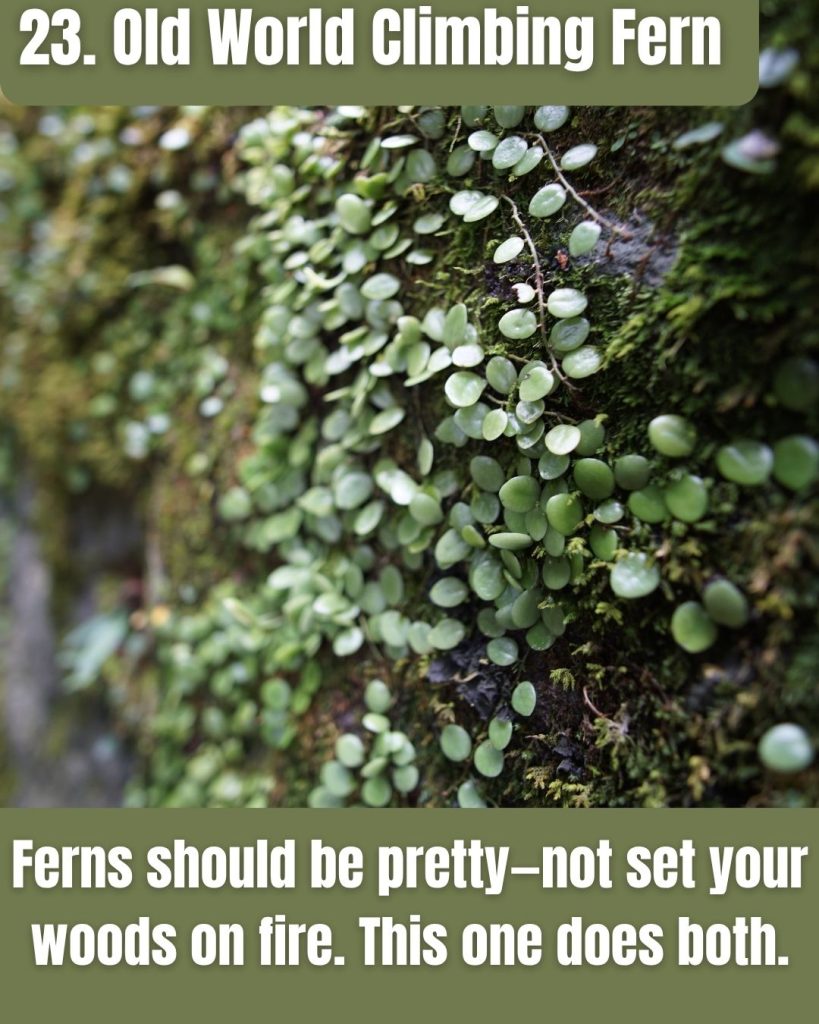
- Vine smotherer: Covers trees, shrubs, and wetlands in thick mats.
- Wildfire spreader: Carries flames high into tree canopies during burns.
- Rapid growth: Can regrow from tiny fragments left after cutting.
This fast-growing fern can cover entire forests and wetlands in a matter of months.
It blocks sunlight, chokes out native plants, and acts as a dangerous ladder for wildfires, helping flames leap up into the tree canopy where they’re much harder to control.
Melaleuca (Melaleuca quinquenervia)
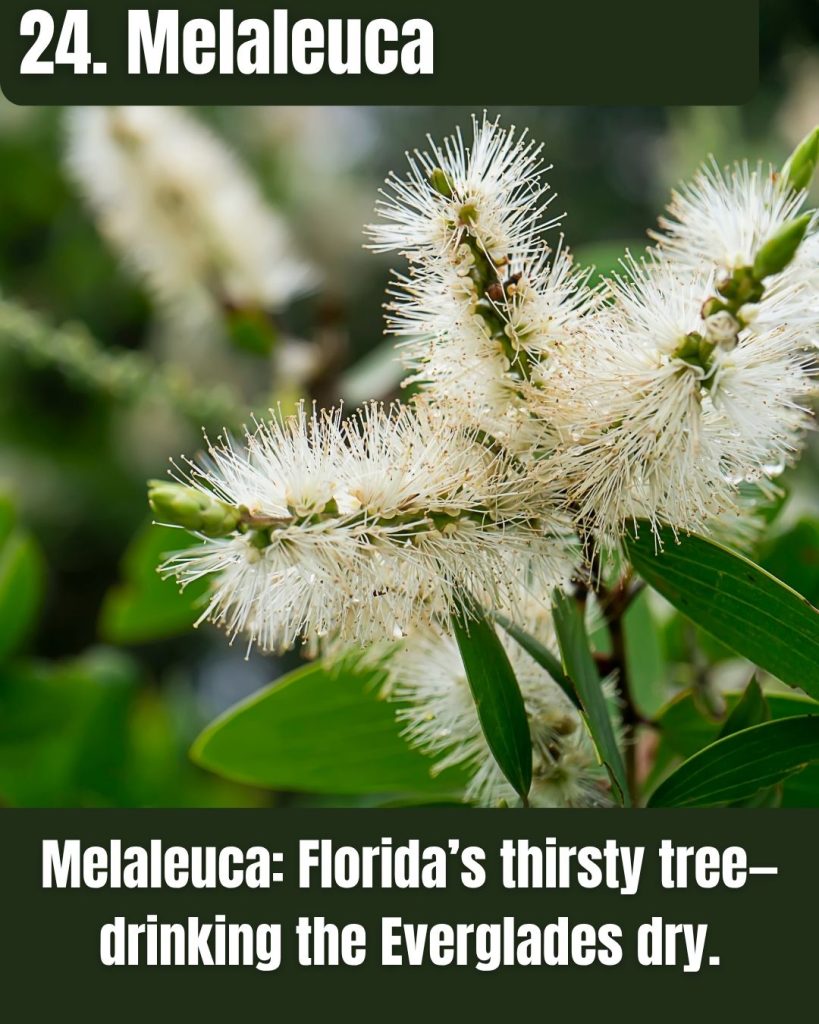
- Water hog: Drains wetlands and outcompetes sawgrass in the Everglades.
- Hard to kill: Resprouts vigorously after cutting or burning.
- Blanket spreader: Forms dense monocultures that crowd out all other life.
Brought in to dry out swamps, melaleuca quickly turned the tables.
It now dominates huge areas of the Everglades, pushing out native plants, sucking up water, and creating fire hazards with its flammable bark and dense litter.
Water Hyacinth (Eichhornia crassipes)

- Floating menace: Chokes rivers and lakes, blocks boats and swimmers.
- Rapid spreader: Doubles population in two weeks.
- Oxygen thief: Decomposing mats kill fish by depleting water oxygen.
Water hyacinth forms thick, floating mats that block sunlight, suffocate native plants, and deplete oxygen as they rot—killing fish and making boating and swimming nearly impossible.
It’s so fast-growing that it can double its mass in just two weeks!